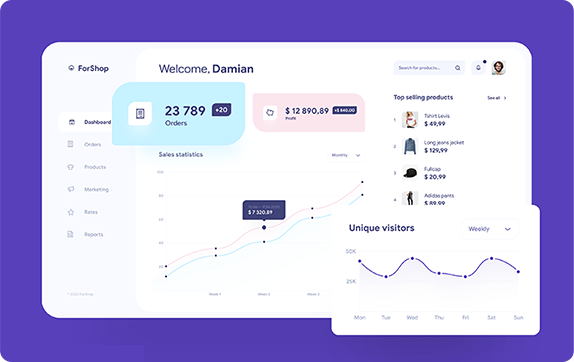
Business Intelligence (BI) Solutions Project Overview
Empower decision-making with our Business Intelligence (BI) Solutions project, transforming raw data into strategic insights for a competitive edge in the digital landscape.
Empowering Decision-Making with SUNSAKTECH Business Intelligence (BI) Solutions
I. Introduction: In the data-driven landscape of modern business, SUNSAKTECH undertakes a transformative project to develop advanced Business Intelligence (BI) solutions. This initiative aims to empower organizations with actionable insights, streamlined reporting, and data-driven decision-making capabilities.
II. Project Objectives:
-
Data Integration and Aggregation: Develop BI solutions that seamlessly integrate and aggregate data from various sources, providing a comprehensive view of organizational performance.
-
Interactive Dashboards: Create interactive and visually appealing dashboards that allow users to explore data, analyze trends, and gain actionable insights through user-friendly interfaces.
-
Real-Time Data Analytics: Implement real-time data analytics capabilities to ensure that decision-makers have access to the most up-to-date information for timely and informed decisions.
-
Predictive Analytics: Integrate predictive analytics models to forecast trends, identify opportunities, and mitigate risks, providing a forward-looking perspective for strategic planning.
-
Customizable Reporting: Enable users to generate customizable reports tailored to their specific needs, ensuring that stakeholders can easily access and interpret relevant data.
-
Data Security and Governance: Implement robust data security measures and governance policies to ensure the confidentiality, integrity, and availability of sensitive business information.
-
Cross-Functional Integration: Develop BI solutions that seamlessly integrate with various departments and functions within an organization, fostering cross-functional collaboration and data sharing.
-
User Training and Support: Provide comprehensive training resources and support to ensure that users at all levels can effectively navigate and utilize the BI solutions for their decision-making needs.
-
Scalability: Design the BI solutions with scalability in mind, accommodating growing data volumes and user demands as the organization evolves.
-
Continuous Improvement: Implement mechanisms for continuous improvement based on user feedback, technological advancements, and changes in organizational requirements.
III. Project Phases:
-
Assessment and Planning: Conduct a thorough assessment of organizational BI needs, existing data infrastructure, and user requirements. Develop a detailed project plan outlining key milestones, timelines, and resource requirements.
-
Data Integration and Modeling: Establish processes for data extraction, transformation, and loading (ETL), ensuring seamless integration of data from diverse sources. Develop data models to support effective BI analysis.
-
Dashboard and Report Design: Collaborate on the design phase, creating interactive dashboards and customizable reports. Incorporate user feedback to refine the design for optimal usability.
-
Analytics and Predictive Modeling: Integrate analytics tools and predictive modeling capabilities to enable advanced data analysis and forecasting. Ensure the accuracy and reliability of predictive models.
-
Security Implementation: Implement robust security measures, including user authentication, data encryption, and access controls, to safeguard sensitive business information.
-
Integration with Existing Systems: Ensure seamless integration with existing organizational systems, databases, and applications to maximize the value of BI solutions.
-
User Training and Rollout: Provide comprehensive training to users at different levels within the organization. Roll out the BI solutions gradually, ensuring a smooth transition and user adoption.
-
Testing and Quality Assurance: Conduct rigorous testing to identify and address any issues related to data accuracy, dashboard functionality, and overall system performance.
-
Scalability Testing: Evaluate the scalability of the BI solutions to ensure they can handle increased data volumes and user interactions as the organization grows.
-
Continuous Monitoring and Improvement: Implement tools for monitoring BI solution performance, user engagement, and data accuracy. Continuously gather user feedback for ongoing improvements.
IV. Technologies and Tools:
- BI Platforms: Tableau, Power BI, QlikView, or customized BI solutions based on organizational requirements.
- ETL Tools: Apache NiFi, Talend, Microsoft SSIS, or equivalent.
- Database Management Systems: MySQL, PostgreSQL, Microsoft SQL Server, or equivalent.
- Predictive Analytics: Python (scikit-learn, TensorFlow), R, or specialized predictive analytics tools.
- Security Measures: SSL encryption, multi-factor authentication, role-based access controls.
- Dashboard and Report Design: HTML, CSS, JavaScript, or specialized BI design tools.
V. Conclusion: The SUNSAKTECH Business Intelligence Solutions project is not just about data analysis; it's about empowering organizations with the tools they need to thrive in a data-centric business environment. As we embark on this journey, the goal is clear: to develop BI solutions that not only meet current organizational needs but also provide a foundation for continuous growth and innovation. Welcome to a future where data is not just information; it's a strategic asset driving success and informed decision-making.
